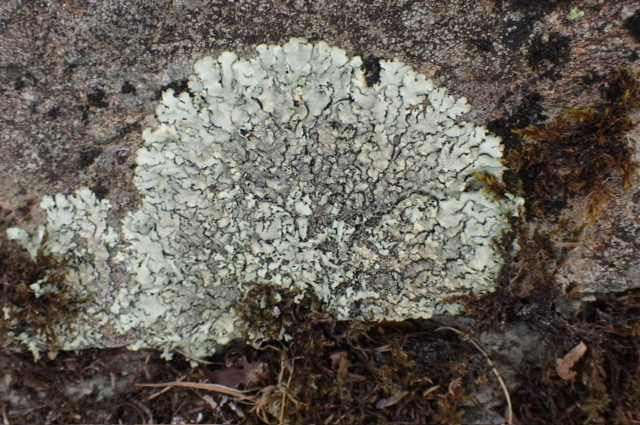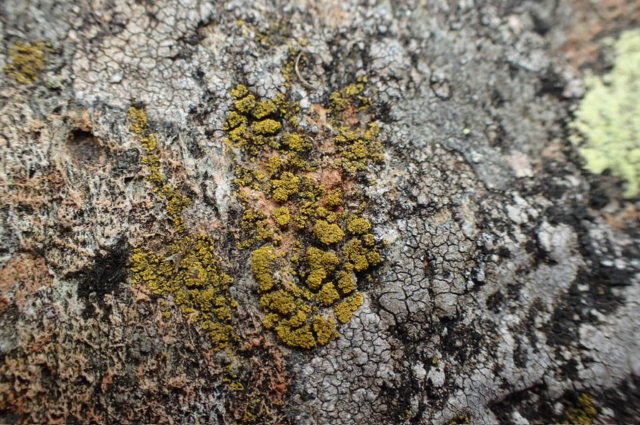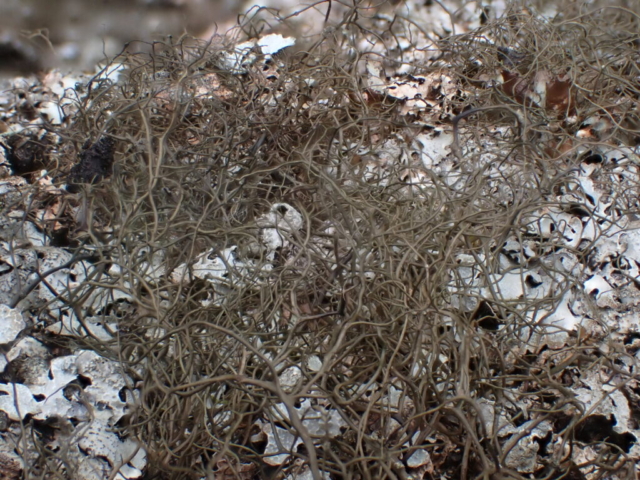Ten of us gathered on a sunny May morning to look at lichens. We crossed the road, went through a gate and there was a slope. Small outcrops beckoned. The bracken wasn’t yet tall enough to be in the way. Yellowhammers wheezed about no cheese. This was Caz and Chris’s local patch, and they had an itinerary planned…
Outcrop one had some very impressive Massalongia carnosa: it was strange to see it dry. There were lichens to explain to first timers: Rhizocarpon geographicum; a conspiracy of Cladonias; Ochrolechia androgyna to demonstrate a C+ red reaction on; Pertusaria corallina for K+ yellow; Ephebe lanata to stroke.
Heading across the slope (and edging a little bit higher) we came to an outcrop where Chris and Caz had previously found Lecidea fuliginosa. It’s not in Dobson, so there had been some uncertainty. I’d not seen it before: it’s an interesting brown nobbly crust, with darker black-brown apothecia. My photos suggest the lichen equivalent of home-made chocolate chip cookies, but maybe I’m taking the food analogies too far. There was also a Small Copper butterfly, interesting little still-lifes of Cladonia furcata and very fertile Xanthoparmelia conspersa; a good example of Lecanora sulphurea taking over (i.e. parasitising the algae of) another lichen. Was it Tephromela atra or Lecanora gangaleoides? I must admit I didn’t check.
There was Ochroclechia tartarea and parella to compare; Diploschistes scruposus hiding yellow tinged behind an outcrop, and Lecidea grisella’s cracks to ponder. We found some shiny Cetraria aculeata too.
Lunch was taken in the shelter of a little quarry, which occupied us for a while afterwards. There was Opegrapha zonata and O.gyrocarpa (now renamed Enterographa zonata and Gyrographa gyrocarpa respectively) to discuss, and some evidence of metals in the rock: Tremolecia atrata looked rusty and there were Stereocaulons aplenty. I’d not tried the KC test on S. evolutum before: it gives a fleeting “violet”. Well, a different colour from the C and the K anyway.
A little further uphill and there was a dramatic boulder: Bryoria fuscescens cascaded for several feet down the lower side. There was Tuckermanopsis chlorophylla to compare with nearby Platismatia glauca, hi-vis Arthrorhaphis citrinella and an intriguing Lecanora with pearly pruinose apothecia: C-, K+ yellow, P+ orange. There was a suggestion that this was Lecanora subcarnea, but the chemistry didn’t agree with Dobson. Though it looked like the picture. The puzzlement was resolved back at base when it transpired that the chemistry listed in LGBI3 agreed with our “in the field” records: result! Another new one for me.
Over the top of the next knoll was a little area of heath. Hands and knees alternated with standing and staring at our toes. Apart from Cladonia we found a couple of pieces of Cetraria islandica: cue a debate about pronunciation. And a small population of Cetraria muricata: much more spiny, closer together, pseudocyphellae not in pits.
A short wander took us to the slope overlooking Haweswater and the green expanse of Naddle woods. The Willow Warbler chorus that had been with us all day continued. There was Protoparmelia badia on the final erratic, a last chance of the day to say “ornithocoprophilous” (whilst looking at probable Xanthoria ucrainica) and a great expanse of Parmelia omphalodes, split by a line of bilberry.
Thank you everyone for coming, Caz and Chris for the planning, and the weather gods for being kind. All in all it was a very good start to the rocky summer season (as opposed to the winter woods).
Text: Pete Martin
Photos: Chris Cant, John Adams, Pete Martin


















